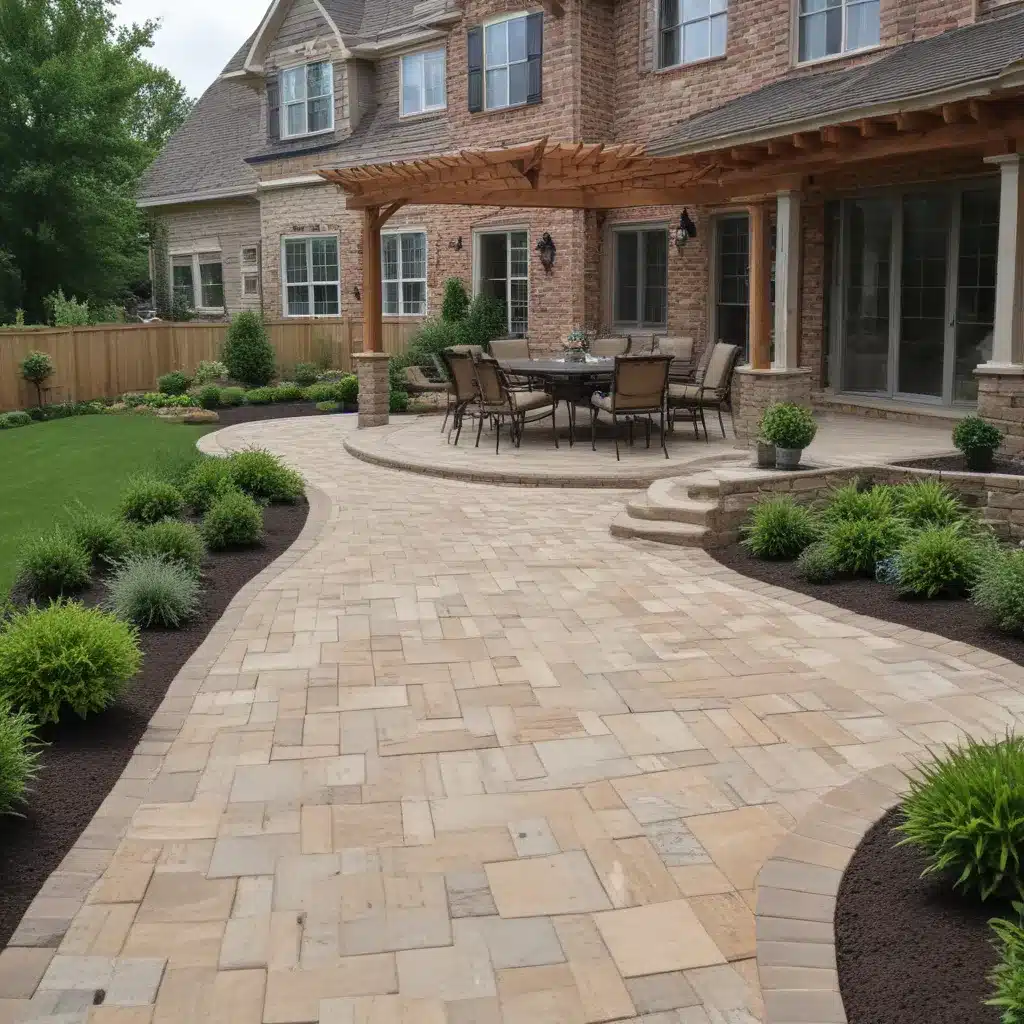
Patio Paving and Landscaping: Creating a Cohesive Outdoor Retreat in Cincinnati
As an experienced outdoor living consultant, I’ve had the pleasure of working with homeowners across the Cincinnati area to transform their backyards into personalized oases. Whether you’re seeking to host lively gatherings or cultivate a tranquil garden retreat, the key to creating a captivating outdoor space lies in harmonizing your patio paving and landscaping elements.
Patio Paving Trends
When it comes to patio paving, homeowners in Cincinnati have a wealth of options to choose from, each offering its own unique aesthetic and practical benefits. Natural stone materials like limestone, bluestone, and slate have long been fan-favorites for their timeless appeal and exceptional durability. These versatile pavers can be laid in a variety of patterns to suit any design style, from classic running bond to more contemporary geometric layouts.
For a more sustainable approach, permeable pavers have gained popularity in recent years. These pavers feature minute gaps that allow rainwater to filter through the surface, reducing runoff and recharging groundwater supplies. Not only do permeable options mitigate environmental impact, but they also help to prevent pooling and slippery conditions on the patio.
When planning your patio paving design, it’s important to carefully consider factors such as the size and shape of your outdoor space, the overall architectural style of your home, and your desired aesthetic. Larger patio areas may benefit from a mix of materials, such as limestone borders framing a central exposed aggregate or concrete paver field. Alternatively, smaller patios can create an impactful visual statement with a single paving material, like sleek porcelain tiles or rustic flagstone.
Outdoor Design Ideas
Once you’ve selected the ideal paving material for your Cincinnati patio, it’s time to start integrating complementary landscaping elements to cultivate a cohesive, inviting outdoor retreat.
Incorporating lush greenery through strategically placed garden beds, potted plants, and trailing vines can soften the hardscaping and inject a sense of natural beauty. For a more structured approach, consider incorporating linear landscaping features, such as low hedges or raised planter boxes, to define the patio’s boundaries and create a sense of enclosure.
When it comes to functional space planning, leverage the patio’s unique layout to carve out distinct zones for various activities. A cozy seating area with comfortable outdoor furniture can become the perfect spot for relaxation and casual gatherings, while a designated dining space adjoining the patio can facilitate alfresco meals. For the ultimate in outdoor living, consider adding a built-in kitchen or fire pit to transform your patio into a true extension of your home.
To further enhance the aesthetic appeal of your patio, explore decorative accents that tie the space together. Elegant lighting fixtures, such as path lighting or hanging lanterns, can set the mood and extend the usability of your outdoor living area. Strategically placed water features, like a tranquil fountain or a small reflecting pool, can introduce a soothing ambiance and visual interest.
Installation Techniques
Proper patio installation is crucial to ensuring the longevity and functionality of your outdoor retreat. Before laying the pavers, it’s essential to prepare the base properly. This involves excavating the area, compacting the soil, and adding a sturdy foundation of gravel or crushed stone to provide a stable and well-drained surface.
When it comes to laying the paving stones, attention to detail is paramount. Skilled installers will meticulously align the pavers, maintain consistent joint spacing, and ensure a smooth, level finish. Depending on the material, they may also incorporate edge restraints and polymeric sand to lock the pavers in place and prevent settling or shifting over time.
Proper drainage is another critical factor in patio design and installation. By strategically incorporating slope and catchment areas, installers can effectively channel water away from the patio, preventing pooling and potential damage to the surface.
Maintenance Guidelines
To keep your Cincinnati patio looking its best for years to come, it’s essential to follow a regular maintenance routine. Periodic cleaning with a soft-bristle brush and mild detergent can help remove any accumulated dirt or debris, while sealing the pavers every 2-3 years can protect the surface from weathering and stains.
In the event of cracked or damaged pavers, a skilled installer can easily replace individual units without disrupting the entire patio. And when it comes to seasonal care, a thorough fall cleanup to clear leaves and debris, coupled with winter storage of any delicate furniture or decor, can help ensure your patio remains in pristine condition.
Cost Considerations
When budgeting for your Cincinnati patio project, there are several key factors to consider. Paving material costs can vary widely, from budget-friendly options like concrete pavers to more premium natural stone. Homeowners should also account for labor and installation fees, which can be influenced by the complexity of the design, the preparation required, and the expertise of the contractor.
To help manage your patio budget, it’s a good idea to obtain multiple quotes from reputable local contractors. Don’t be afraid to compare material and labor costs to ensure you’re getting the best value for your investment. And remember, while the initial price tag is important, prioritizing quality and durability can pay off in the long run with reduced maintenance and increased enjoyment of your outdoor living space.
Ready to transform your Cincinnati backyard into a cohesive, inviting outdoor retreat? Contact Cincinnati Patiopaving today to schedule a consultation and begin your journey towards the perfect patio paving and landscaping project.

